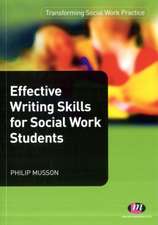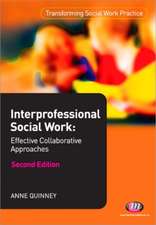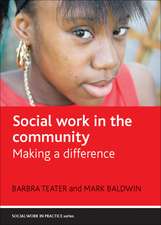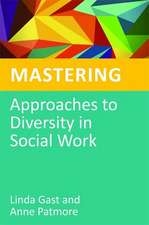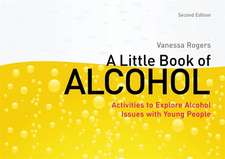Aging in a Second Language: A Case Study of Aging, Immigration, and an English Learner Speech Community: International Perspectives on Aging, cartea 17
Autor Steven L. Arxer, Maria del Puy Ciriza, Marco Shappecken Limba Engleză Hardback – 8 iun 2017
Included in the coverage:
- Minority aging in an immigrant context.
- Late-life second language acquisition: cognitive andpsycholinguistic changes, challenges, and opportunities.
- Building emotions for self-identity and learning.
- Practicing safe language socialization in private and public spaces.
- Language resocialization and gender allies.
- Aging, second language acquisition, and health.
| Toate formatele și edițiile | Preț | Express |
|---|---|---|
| Paperback (1) | 577.54 lei 6-8 săpt. | |
| Springer International Publishing – 2 aug 2018 | 577.54 lei 6-8 săpt. | |
| Hardback (1) | 583.78 lei 6-8 săpt. | |
| Springer International Publishing – 8 iun 2017 | 583.78 lei 6-8 săpt. |
Din seria International Perspectives on Aging
-
 Preț: 297.77 lei
Preț: 297.77 lei - 20%
 Preț: 567.78 lei
Preț: 567.78 lei - 18%
 Preț: 901.64 lei
Preț: 901.64 lei - 15%
 Preț: 631.07 lei
Preț: 631.07 lei - 20%
 Preț: 576.07 lei
Preț: 576.07 lei - 15%
 Preț: 646.11 lei
Preț: 646.11 lei -
 Preț: 392.37 lei
Preț: 392.37 lei - 15%
 Preț: 648.42 lei
Preț: 648.42 lei - 18%
 Preț: 953.35 lei
Preț: 953.35 lei -
 Preț: 394.87 lei
Preț: 394.87 lei - 24%
 Preț: 694.69 lei
Preț: 694.69 lei - 15%
 Preț: 698.94 lei
Preț: 698.94 lei -
 Preț: 446.37 lei
Preț: 446.37 lei - 18%
 Preț: 946.55 lei
Preț: 946.55 lei - 18%
 Preț: 785.42 lei
Preț: 785.42 lei - 15%
 Preț: 642.36 lei
Preț: 642.36 lei - 15%
 Preț: 582.80 lei
Preț: 582.80 lei - 18%
 Preț: 781.31 lei
Preț: 781.31 lei - 18%
 Preț: 889.29 lei
Preț: 889.29 lei - 18%
 Preț: 781.15 lei
Preț: 781.15 lei - 18%
 Preț: 1104.25 lei
Preț: 1104.25 lei - 15%
 Preț: 636.80 lei
Preț: 636.80 lei -
 Preț: 439.64 lei
Preț: 439.64 lei - 15%
 Preț: 473.49 lei
Preț: 473.49 lei - 24%
 Preț: 785.90 lei
Preț: 785.90 lei - 5%
 Preț: 1649.70 lei
Preț: 1649.70 lei - 18%
 Preț: 786.36 lei
Preț: 786.36 lei - 15%
 Preț: 651.99 lei
Preț: 651.99 lei
Preț: 583.78 lei
Preț vechi: 686.79 lei
-15% Nou
Puncte Express: 876
Preț estimativ în valută:
111.70€ • 116.64$ • 92.24£
111.70€ • 116.64$ • 92.24£
Carte tipărită la comandă
Livrare economică 15-29 aprilie
Preluare comenzi: 021 569.72.76
Specificații
ISBN-13: 9783319576084
ISBN-10: 3319576089
Pagini: 154
Ilustrații: IX, 154 p.
Dimensiuni: 155 x 235 mm
Greutate: 0.41 kg
Ediția:1st ed. 2017
Editura: Springer International Publishing
Colecția Springer
Seria International Perspectives on Aging
Locul publicării:Cham, Switzerland
ISBN-10: 3319576089
Pagini: 154
Ilustrații: IX, 154 p.
Dimensiuni: 155 x 235 mm
Greutate: 0.41 kg
Ediția:1st ed. 2017
Editura: Springer International Publishing
Colecția Springer
Seria International Perspectives on Aging
Locul publicării:Cham, Switzerland
Cuprins
Introduction.- Aging as a Hispanic in a Second or Foreign Language.- Aging among Hispanic immigrants: risks and challenges.- The language effect and immigrant aging well-being.- Applied Linguistics and Contextualizing Older Hispanic Language Acquisition.- Social constructivism and the role of place for immigrant language learners.- Dallas area case study on older immigrant English second language learners.- Aging in Place: The Restructuring of Formal and Informal Immigrant Arrangements.- Building emotions for self-identity and learning.- Family and social networks.- Practicing public socialization in safe places: work education and health.- Language resocialization and gender allies.- Conclusion.
Notă biografică
Steven L. Arxer, Ph.D. is associate professor at the University of North Texas at Dallas in the Department of Sociology and Psychology. He specializes in qualitative research on minority populations, with a focus on intersectionality, aging and development.
Maria Ciriza-Lope, Ph.D. is assistant professor at the University of North Texas at Dallas in the Department of Languages and Communication. She is an expert on language contact, Spanish heritage language pedagogy and language revitalization movements.
Marco Shappeck, Ph.D. is assistant professor at the University of North Texas at Dallas in the Department of Teacher Education and Administration. He specializes in linking education applications of sociolinguistic research to the teaching of English and Spanish as a second or foreign language.
Maria Ciriza-Lope, Ph.D. is assistant professor at the University of North Texas at Dallas in the Department of Languages and Communication. She is an expert on language contact, Spanish heritage language pedagogy and language revitalization movements.
Marco Shappeck, Ph.D. is assistant professor at the University of North Texas at Dallas in the Department of Teacher Education and Administration. He specializes in linking education applications of sociolinguistic research to the teaching of English and Spanish as a second or foreign language.
Textul de pe ultima copertă
This unique account of English language acquisition by Latino elders shines intimate light on the increasingly complex concerns of aging immigrant minority populations. Rich qualitative findings detail sociocultural barriers to and social and emotive factors that promote second language acquisition in older age. The book’s case study highlights diverse cognitive and social processes as elders establish a sense of self as learners and as part of a learning community, and a sense of place as newcomers navigating a challenging environment. And first-person comments from the group members deftly illustrate the intricacies of being an immigrant in a rapidly changing America as well as the myriad intersections of race/ethnicity, gender, culture, and country that shape immigrant life.
Included in the coverage:
- Minority aging in an immigrant context.
- Late-life second language acquisition: cognitive and psycholinguistic changes, challenges, and opportunities.
- Building emotions for self-identity and learning.
- Practicing safe language socialization in private and public spaces.
- Language resocialization and gender allies.
- Aging, second language acquisition, and health.
Caracteristici
Examines minority aging through intersection of immigration and second language socialization Emphasizes the Mexican origin population Presents longitudinal, qualitative case study data Includes supplementary material: sn.pub/extras Includes supplementary material: sn.pub/extras


